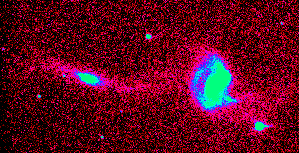If a low mass galaxy passes head-on through
the center of a disk galaxy, a
ring galaxy is created.
In an off-center collision, a partial
ring may be created.
An example of such a partial ring is seen in
the interacting pair NGC 7714/5 (Arp 284).
At optical (red) wavelengths, NGC 7714/5 looks like this:
 NGC 7714 is to the right (west) and NGC 7715 to the east.
The galaxies
are separated by 2 arcminutes (25 kiloparsecs).
Notice the stellar bridge between the galaxies and
the tidal tails extending from both galaxies.
Note that NGC 7714 has a partial ring.
This image was obtained with the 2.1m telescope
at
McDonald Observatory in collaboration with
Rick
Pogge (Ohio State University).
NGC 7714 is to the right (west) and NGC 7715 to the east.
The galaxies
are separated by 2 arcminutes (25 kiloparsecs).
Notice the stellar bridge between the galaxies and
the tidal tails extending from both galaxies.
Note that NGC 7714 has a partial ring.
This image was obtained with the 2.1m telescope
at
McDonald Observatory in collaboration with
Rick
Pogge (Ohio State University).
To see a better optical image from the
Arp Atlas,
click
here.
To see a mpeg movie of a simulation of the NGC 7714 and NGC 7715 encounter,
click here (from
Smith and Wallin 1992,
Astrophysical Journal, vol. 393, p. 544).
In this model, the smaller galaxy has a mass of 1/3 that
of the larger galaxy and the impact parameter is 0.85 times
the radius of the larger disk.
Compare the
final frame with the McDonald optical image shown above.
Notice
that the ring, the bridge, and the tails are successfully reproduced.
This is a restricted 3-body model (only includes gravitational forces between the
particles and the two centers of mass; it does not calculate all the individual
gravitational forces between the various particles).
This model only contains stars.
More recently,
Curt Struck (Iowa State)
and I have constructed a full N-body model (including all the individual forces),
which includes both stars and gas. This model is described in
Struck and
Smith 2003, Astrophysical Journal, vol. 589, p. 157.
To see an animation of such a model,
click
here.
The distribution of interstellar atomic hydrogen
in the NGC 7714/5 system looks like this:

These data were obtained with the
Very Large Array,
part of the
National Radio Astronomy Observatory.
This map has 12 arcsecond resolution.
The gas distribution is color-coded, with the highest
column density red and lowest blue.
The yellow contours are optical data from the
Digitalized
Palomar Observatory Sky Survey, smoothed
to 12 arcseconds
resolution.
Notice the complete loop of gas to the northwest
of NGC 7714. Also notice that
the gas in the bridge and eastern tail
is shifted to the north relative to the
stars. Such offsets may be caused by the different behavior of
gas and stars during a galaxy collision: the stars do not collide,
but the gas clouds do.
(From
Smith, Struck, and Pogge 1997,
Astrophysical Journal, 483, 754).
For an H-alpha+[N II]
optical image of this system showing
the location of the star forming regions,
click
here
.
Note that young stars are forming in the bridge
(From
Smith, Struck, and Pogge 1997,
Astrophysical Journal, 483, 754).
To see Chandra X-ray images of NGC 7714/5, click
here (from Smith, Struck, and Nowak 2005, Astronomical Journal,
in press).
Spitzer infrared images of Arp 284 were published as
part of the
`Spirals, Bridges, and Tails'
project in
Smith
et al. (2007), Astronomical
Journal, 133, 791.
The Spitzer images of
Arp 284 are visible
here.
Also see our Hubble/Spitzer/GALEX paper on NGC 7714/5:
B. W. Peterson, C. Struck, B. J. Smith, and M. Hancock (2009),
`Star Clusters in the Interacting Galaxy System Arp 284',
M.N.R.A.S., submitted
To see another galaxy which has probably
undergone an off-center collision,
click
here
To return to
Beverly Smith's web page, click
here
Last updated: 6/15/09
 NGC 7714 is to the right (west) and NGC 7715 to the east.
The galaxies
are separated by 2 arcminutes (25 kiloparsecs).
Notice the stellar bridge between the galaxies and
the tidal tails extending from both galaxies.
Note that NGC 7714 has a partial ring.
This image was obtained with the 2.1m telescope
at
McDonald Observatory in collaboration with
Rick
Pogge (Ohio State University).
NGC 7714 is to the right (west) and NGC 7715 to the east.
The galaxies
are separated by 2 arcminutes (25 kiloparsecs).
Notice the stellar bridge between the galaxies and
the tidal tails extending from both galaxies.
Note that NGC 7714 has a partial ring.
This image was obtained with the 2.1m telescope
at
McDonald Observatory in collaboration with
Rick
Pogge (Ohio State University).
